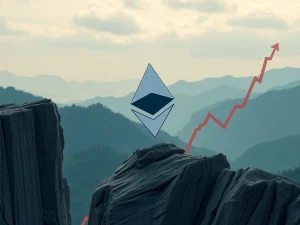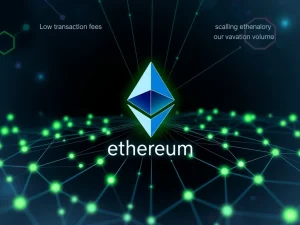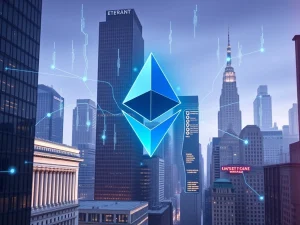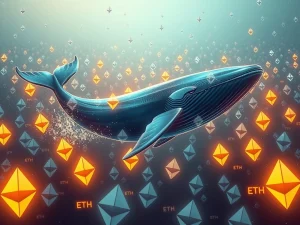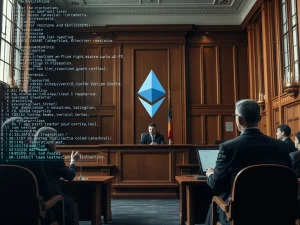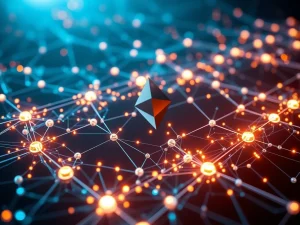Base L2’s Crucial Role: Vitalik Buterin Defends Ethereum Layer-2 Amid Regulatory Scrutiny
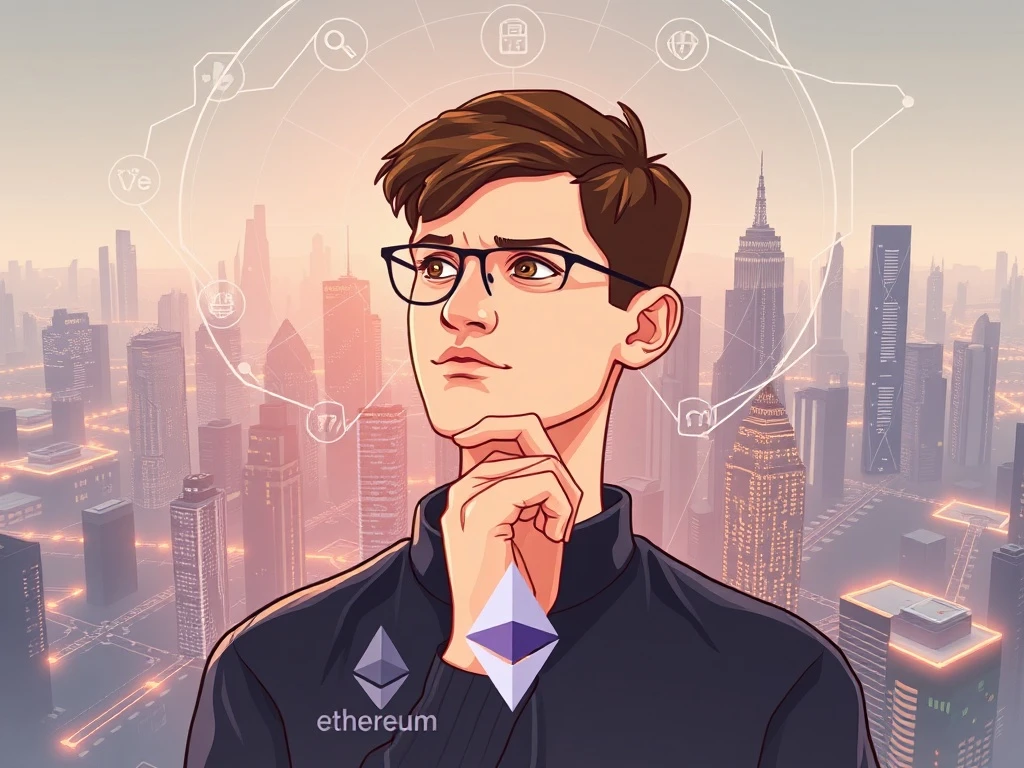
The cryptocurrency world often faces intense scrutiny. Recently, Ethereum layer-2 networks, including Coinbase’s Base, have entered the regulatory spotlight. This has sparked considerable debate. Ethereum co-founder Vitalik Buterin has now stepped forward. He offers a powerful defense of Base L2, clarifying its position within the broader blockchain ecosystem.
Vitalik Buterin Champions Base L2’s Approach
Ethereum co-founder Vitalik Buterin recently praised Base L2. He highlighted its innovative approach to decentralization. Buterin’s comments address growing concerns. These concerns surround Base’s sequencer and its potential classification as an exchange. His intervention provides crucial clarity. It reinforces the foundational principles of true layer-2 solutions.
On Tuesday, Buterin stated, “Base is doing things the right way.” He explained its structure. Base operates as an L2 on top of Ethereum. It leverages centralized features for enhanced user experience. Yet, it remains deeply connected to Ethereum’s decentralized base layer for security. This dual approach offers significant benefits. It combines efficiency with robust protection. Buterin further clarified Base’s non-custodial nature. “They cannot steal funds or stop you from withdrawing funds,” he affirmed. This distinction is vital. It separates true layer-2s from centralized platforms. These networks act as extensions of Ethereum. They are not merely “glorified servers that happen to submit hashes.” This perspective is key to understanding their fundamental role.
Buterin’s remarks arrived during a period of intense skepticism. The definition of layer-2 networks faced scrutiny. Concerns about centralization grew. This debate intensified following comments by SEC Commissioner Hester Peirce. She spoke on a podcast on September 7. Her statements fueled speculation. They questioned the regulatory future of these essential blockchain components.
Understanding L2 Regulation and Centralization Fears
Many layer-2 networks utilize centralized transaction sequencing. This offers several advantages. It provides better transaction rates. It also helps prevent front-running by bots. However, this centralization has attracted regulatory attention. Commissioner Peirce alluded to potential regulatory implications. She focused on whether these “matching engines” resemble centralized exchanges. This raised significant questions regarding L2 regulation.
Peirce posed a critical question. “If you have a matching engine that’s essentially controlled by one entity that controls all the pieces of that, then that looks a lot more like an exchange, and we’re going to have to think about that.” This statement put L2 operators on high alert. The classification as an exchange would carry severe consequences. It would necessitate extensive registration and compliance with SEC requirements. Such a move could significantly restrict operations. This explains the industry’s strong pushback. However, Peirce also offered a caveat. If the assets being “matched” are not securities, then the SEC might have “not a lot to say about it.” This nuance provides a sliver of hope. It highlights the importance of asset classification in the regulatory debate.
The distinction between an L2 sequencer and an exchange remains paramount. An exchange provides a marketplace. It brings together buyers and sellers of securities. Layer-2s, conversely, serve as infrastructure providers. They process messages as code. They call smart contracts. They batch all transactions. These transactions include payments, calls, or messages. Their function is broad and foundational. It differs significantly from a traditional trading venue.
Blockchain Sequencers: Infrastructure, Not Exchanges
Coinbase chief legal officer Paul Grewal argued against classifying layer-2 sequencers as “exchanges.” He believes this fundamentally misunderstands their function. Grewal highlighted the SEC’s definition of an exchange. It involves providing a marketplace for securities. He asserted that layer-2s are “general-purpose blockchains.” They operate as infrastructure. They process code and batch transactions. This distinction is critical for understanding blockchain sequencers.
Grewal drew a compelling analogy. He compared layer-2s like Base to Amazon Web Services (AWS). Both run code provided by developers. This includes exchange applications. However, this does not make the infrastructure provider itself an exchange. “If an exchange runs on AWS, is AWS an exchange? Obviously not,” he stated. This analogy effectively illustrates the separation of roles. It emphasizes that providing the underlying technology differs from facilitating trades directly. The sequencer’s role is to order transactions. It does not match buy and sell orders. This crucial difference safeguards the classification of L2s.
Base co-founder Jesse Pollak further elaborated on sequencer functionality. Users can transact through Base’s sequencer. Alternatively, they can transact directly through Ethereum. This maintains full decentralization and censorship resistance. Pollak used another clear analogy. “It’s like a traffic controller ensuring smooth flow through a high-priority traffic lane that enables vehicles to get where they’re going faster.” This metaphor perfectly describes the sequencer’s role. It optimizes transaction ordering and speed. Importantly, Pollak also cleared up the matching engine misconception. Sequencers do not act as “matching services” or engines. They simply determine the order in which transactions are processed. They do not pair buy and sell orders at specific prices. This distinction is foundational for the entire Ethereum layer-2 ecosystem.
The Future of Ethereum Layer-2 Ecosystem
The debate surrounding layer-2 networks and their regulatory status holds immense importance. Ethereum layer-2 solutions are vital for scalability. They help manage transaction volume. They also reduce fees. Without them, Ethereum’s mainnet would quickly become congested. This would hinder its widespread adoption. Vitalik Buterin’s defense of Base and other L2s reinforces their critical role. He sees them as integral extensions of Ethereum itself. This perspective emphasizes their security inheritance from the mainnet. It also highlights their non-custodial design. These features are fundamental to their decentralized ethos.
The industry’s robust response to regulatory suggestions is understandable. Classifying L2s as exchanges would impose significant burdens. It would stifle innovation. It could also centralize the very systems designed for decentralization. Therefore, clear regulatory frameworks are essential. These frameworks must recognize the unique architecture of L2s. They must distinguish between infrastructure providers and trading venues. The dialogue between regulators and industry leaders is paramount. It will shape the future landscape of decentralized finance. It will also impact the broader blockchain economy.
As the blockchain space evolves, clear definitions become more important. The discussion around Base’s sequencer is a prime example. It highlights the need for precise language. It also shows the importance of technical understanding in regulatory discussions. The ongoing efforts by leaders like Buterin, Grewal, and Pollak aim to provide this clarity. They seek to ensure that innovation can thrive. They also work to protect the decentralized nature of these critical technologies. The future success of Ethereum’s scalability depends heavily on these distinctions. It also relies on a supportive regulatory environment.
Conclusion: Upholding Decentralization and Innovation
Vitalik Buterin’s endorsement of Base L2 offers a strong affirmation. It validates the design principles of true layer-2 networks. He effectively countered recent “FUD.” He clarified that L2s are infrastructure. They are not exchanges. This distinction is crucial. It protects the decentralized nature of these platforms. It also shields them from inappropriate regulatory classification. The arguments presented by industry leaders like Paul Grewal and Jesse Pollak further strengthen this position. They highlight the technical differences between sequencers and matching engines.
The ongoing dialogue between the crypto industry and regulators is vital. It will shape the future of L2 regulation. A clear understanding of blockchain technology is necessary. This understanding prevents misclassification. It also fosters an environment where innovation can flourish. Layer-2 solutions are indispensable for Ethereum’s scalability and efficiency. Therefore, their proper recognition is paramount. This ensures they continue to extend Ethereum’s capabilities securely and effectively. Ultimately, upholding these principles will drive the evolution of decentralized systems for years to come.

